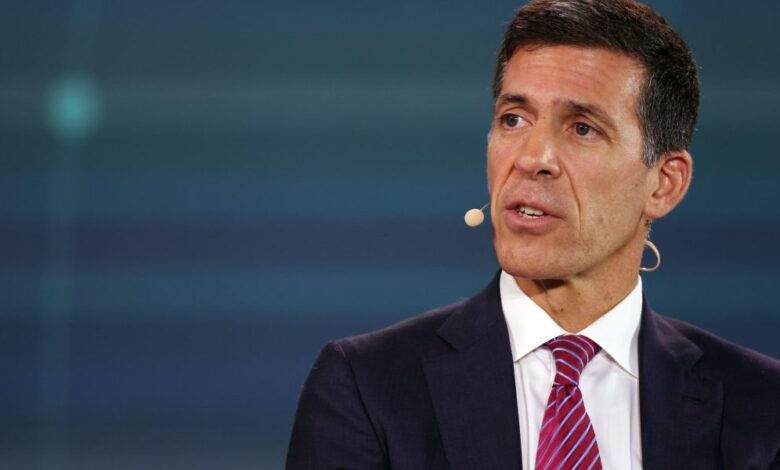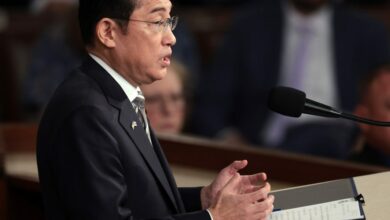The $34 trillion U.S debt is nearly as big as its own economy and there’s (still) no plan to fix it


Officials from several institutions warn a tipping point is near and it will only get worse if it snowballs into a crisis. The national debt is currently almost the same size as the entire U.S. economy, which is roughly $27.3 trillion, according to a Council on Foreign Relations report, and is on track to double within the next thirty years.
In the last few months, officials at several institutions including the International Monetary Fund, Congressional Budget Office and banking giant Goldman Sachs Group have cautioned that the country’s skyrocketing debt is a big problem–literally bigger than ever before–and some fear similar market chaos that derailed former UK Prime Minister Liz Truss’ economy when she was in office in 2022.
The UK economic fiasco under Truss was due to a radical economic proposal of tax cuts and borrowing–which triggered market turmoil in Britain, causing the value of the pound to plummet and Truss to announce her resignation after just six weeks as Prime Minister.
In the U.S., IMF officials have warned that public spending and borrowing will “overheat” the country’s economy, while pushing up funding costs in the rest of the world. Phillip Swagel, the director of the Congressional Budget Office, said the country’s debt is on an “unprecedented” trajectory in an interview with the Financial Times, and could risk a Truss-style economic crisis. John Waldron, the president and COO of Goldman Sachs, expressed a similar concern at Semafor’s World Economic Summit on April 18.
A Truss-style market crash in this country “is a potential risk,” said Lawrence Gillum, chief fixed income strategist at market insights group LPL Financial, especially “if these budget deficits continue to widen.” Still, he said, the collapse that hit the UK isn’t imminent in this country, as treasury auctions, one of the ways the U.S. minimizes debt, are being well-received.
Most weeks, he explained, the U.S Treasury Department holds auctions of long-term securities to help offset debt, and typically, the buyer base for these securities are diverse, including “domestic buyers, like hedge funds and households, and foreign buyers, like Canada and the UK, that started to buy more treasury securities” in recent years. The two largest foreign owners of treasuries are Japan and China, and while the two nations have both been reducing their exposure to the securities, Gillum explained the overall international demand for them hasn’t dropped.
“Those auctions haven’t been alarming enough,” to signify an economic collapse similar to what Truss experienced, he said. Instead, the size of the securities auctioned have been larger.
Still, he insisted, the national debt growth in recent years is “remarkable.”
“It took the U.S. around 220 years to issue $11 trillion of the national debt, but we’ve added $11 trillion of debt over the last four years alone,” Gillum told Fortune, adding that the national deficit spending, or the amount the country spends in relation to how much it collects in taxes, is also “pretty large.”
The country’s current deficit spending is $1.06 trillion, according to fiscal year 2024 data from the Treasury Department, and while there have been large budget deficits in the country for quite some time, Gillum explained, “they usually aren’t as large as they are, absent a war or a recession.” The current budget deficit, Gillum said, is “6% to 8% of gross domestic product levels, which is pretty large in the absence of a financial crisis.”
And as the country gears up for another election year, it’s important to note that policies from both political sides contribute to national debt in different ways.
Debt will be “a big topic on the campaign trail”
“Neither party can really claim fiscal responsibility anymore because both parties have added to the deficit,” Gillum said, citing Trump’s tax cut programs and Biden’s spending on the Inflation Reduction Act. Indeed, several types of spending contribute to the nation’s high debt and policies have been rolled out by both political sides.
On one hand, there’s Bidens’ Inflation Reduction Act of 2022, a range of tax laws and green energy tax credits heralded as a major victory for climate change, that was meant to reduce the nation’s deficit spending but actually increased it. Then, there’s former president Trump’s tax bill, enacted when Republicans gained control of the White House and both houses of Congress in 2017, which cut the corporate tax rate from 35% to 21% and slashed estate taxes for most family farmers and small-business owners.
Simply speaking, Gillum explained, the reason the country has high debt is due to an “increase in spending and decreasing taxes that are driving the budget deficits wider.”
The fix, according to Quincy Krosby, a chief global strategist for LPL Financial, is to raise taxes. “Whether it’s the Democrats or the Republicans, you can choose to raise taxes,” she said, and doing so is “extremely important because Americans across the country believe that billionaires should increase the taxes they pay,” so the government can afford programs like Social Security without deepening its debt.
As it turns out, the national debt is indeed a growing concern for Americans. According to a 2023 Pew Research Center survey about the public’s policy priorities, 57% of Americans believe reducing the budget deficit should be a top priority for the president and Congress to address this year, up from 45% the year prior.
Trump’s tax cut program has cost the country roughly $1.7 trillion as of the end of 2023, according to a Center for American Progress report, and the high accumulation of debt is why Gillum believes Trump’s tax cuts will be “a big topic on the campaign trail.” Along with previous tax cut programs and bipartisan extensions pushed forward by former President George W. Bush, tax cuts have cost $10 trillion–and “are responsible for more than 90 percent of the change in the trajectory of the debt ratio to date and will grow to be responsible for more than 100 percent of the debt ratio increase in the future,” according to the report.
Beyond that, the report found, the tax cuts “largely benefitted the wealthy, despite being paired with a further expansion of the child tax credit.” Trump’s tax cut program is expected to expire in 2025, but that could change if Trump secures a second presidential term.
The costs of higher debt are hidden as the economy keeps growing
The national debt is now higher than it’s ever been before, according to the Treasury Department, and spiked following the government’s response to the pandemic, Gillum said, rising from $22.7 trillion in 2019 to over $30 trillion in 2022. There’s also no plan in place to fix it.
“Unfortunately, politicians probably won’t react until or unless there’s a crisis,” Gillum said, adding “this is one of the things we’ve identified as a potential risk.”
The biggest contributor to national debt, along with years of elevated budget deficits and colossal federal spending during the pandemic, is spending on national emergencies, like major wars and rising healthcare costs, according to Krosby. “All of the benefits that are expected by a large portion of the U.S, especially when it comes to healthcare and Social Security, and also the country’s increasing defense spending, given the complexity of the geopolitical backdrop,” contribute to debt. It’s a problem she acknowledges has gotten out of hand.
To be sure, the nation’s high debt and deficit spending has helped propel the economy forward by giving individuals more money to buy and invest more, and the “amount of debt hasn’t hindered economic growth yet,” Gillum said. High debt does, however, add to “the inflation problem,” he added, saying “it certainly helped the economy grow, but it’s had an impact on higher prices as well.”
Source link




